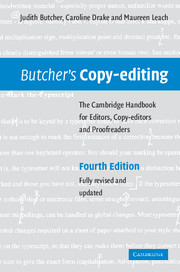Book contents
- Frontmatter
- Contents
- List of illustrations
- Preface to the fourth edition
- Preface to the third edition
- Preface to the second edition
- Preface to the first edition
- Acknowledgements
- 1 Introduction
- 2 Preliminary copy-editing, design and specimen pages
- 3 Preparing the text for the typesetter
- 4 Illustrations
- 5 Proofs
- 6 House style
- 7 Preliminary pages
- 8 Indexes
- 9 Other parts of a book
- 10 Bibliographical references
- 11 Literary material
- 12 Multi-author and multi-volume works
- 13 Science and mathematics books
- 14 Other special subjects
- 15 Reprints and new editions
- 16 On-screen editing
- Appendixes
- Glossary
- Select bibliography and other resources
- Index
11 - Literary material
Published online by Cambridge University Press: 05 August 2012
- Frontmatter
- Contents
- List of illustrations
- Preface to the fourth edition
- Preface to the third edition
- Preface to the second edition
- Preface to the first edition
- Acknowledgements
- 1 Introduction
- 2 Preliminary copy-editing, design and specimen pages
- 3 Preparing the text for the typesetter
- 4 Illustrations
- 5 Proofs
- 6 House style
- 7 Preliminary pages
- 8 Indexes
- 9 Other parts of a book
- 10 Bibliographical references
- 11 Literary material
- 12 Multi-author and multi-volume works
- 13 Science and mathematics books
- 14 Other special subjects
- 15 Reprints and new editions
- 16 On-screen editing
- Appendixes
- Glossary
- Select bibliography and other resources
- Index
Summary
QUOTATIONS
Identify any quotations that are to be displayed (set in smaller type than the text and/or indented, for example), if they are not clearly distinguished. Make sure that it will be immediately obvious to the typesetter where such a passage is to begin and end, especially if the quotation starts or finishes in the middle of a line. See that sources are sensibly placed.
Tell the author about any changes you propose to make in the treatment of quotations, because this is something about which some authors feel strongly.
Layout
Prose
Has the author a sensible system for deciding which quotations should be displayed? It is usual to display prose quotations of more than, say, sixty words, but you could use other criteria; for example:
Run-on those that form an integral part of the sequence of the argument, and display examples on which the author is commenting.
Display small quotations when they are of exactly the same kind as those over sixty words, or where long and short ones are grouped.
Display all the quotations that the author has displayed in the typescript.
In order to give the beginning of the passage a neater appearance, some publishers do not indent the first line of a displayed prose quotation, even if it was originally the beginning of a paragraph.
- Type
- Chapter
- Information
- Butcher's Copy-editingThe Cambridge Handbook for Editors, Copy-editors and Proofreaders, pp. 269 - 293Publisher: Cambridge University PressPrint publication year: 2006



